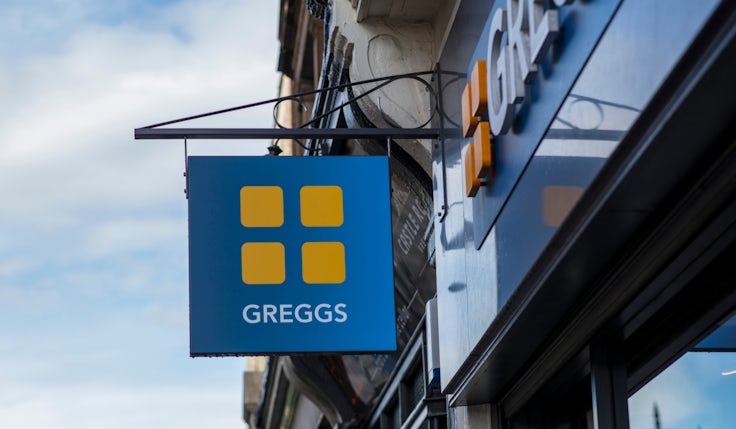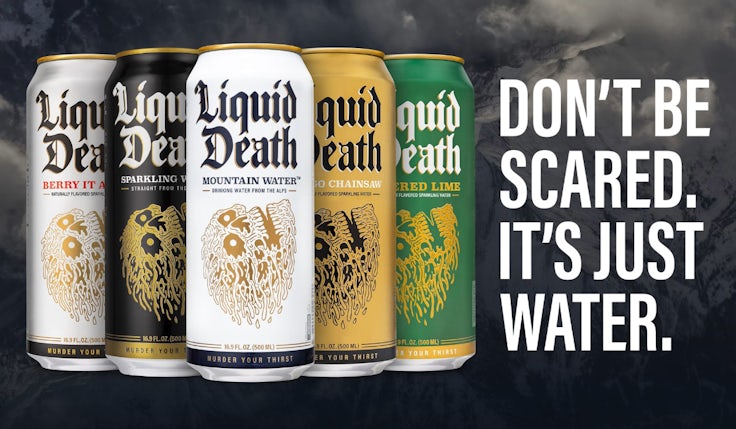2024 year in review: Seven brands that have had a stellar year
From M&S and Greggs to Liquid Death and Nvidia, it has been a very good year for some brands.
 Greggs
Greggs
Greggs has been on a roll in 2024, coming off the back of a very strong few years, the on-the-go food brand has shown no signs of slowing down.
In recent years, the bakery brand has gone from being a mid-morning snack option to a destination for on-the-go food across breakfast, lunch and even evening meal occasions.
Indeed, towards the start of this year, Greggs claimed it had overtaken fast-food giant McDonald’s in the food-to-go breakfast market in the UK, demonstrating that the brand can compete and win in the occasion with consumers.
Speaking in July, CEO Roisin Currie reported that evening sales were growing faster than any other daypart for the brand, and it is increasing its share of the day.
In order to be there for more occasions, Gregg has adapted its product proposition to make it more relevant for consumers at different moments of the day. It expanded its pizza range and introduced new hot food offerings in-store, this year for example. While it has innovated throughout the year, the brand has also continued to offer its customer favourites like sausage rolls and steak bakes.
Physical availability has been another focus for the brand, with it having continuously invested in expanding its store estate to make it more accessible to more consumers.
In 2023, Greggs achieved record brand health metrics, when its consideration score on YouGov’s BrandIndex increased from 36.9 in 2022 to 39, outstripping its category rivals. Its purchase intent score also improved by a statistically significant amount in 2023 versus 2022.
This year the business has continued to build on that, with its brand health measures setting new records for the business, Currie told investors in July. Value and quality have been key focuses for Greggs in particular.
This has all translated into strong commercial success. Despite the ongoing cost of living crisis, Greggs has seen impressive sales growth this year. In the first half of 2024, sales grew by 13.8% versus the year prior. This double-digit growth continued into the third quarter, with sales up 10%.
“Our continued sales success reflects the strength of the brand, and is founded on exceptional quality and value that Greggs offers to customers who need food and drink while on the go,” Currie asserted in July. NC
Liquid Death
 You couldn’t so much as blink at LinkedIn in 2024 without a veritable feast of opinions and thoughts on the marketing strategy of Liquid Death. Yup, love it or hate it, everyone was talking about Liquid Death.
You couldn’t so much as blink at LinkedIn in 2024 without a veritable feast of opinions and thoughts on the marketing strategy of Liquid Death. Yup, love it or hate it, everyone was talking about Liquid Death.
And why not? After all, its bold, off-kilter approach to marketing what is a most basic of product – a can of water – is testament to the power that marketers have to make the public care about even the most rudimentary item if there’s a solid strategy behind it.
The brand’s vice-presidemt of marketing Greg Fass told Marketing Week in February that the team approaches its marketing communications with the energy of an “SNL writer’s room” and that “we win if we make them laugh”. And while its viral social media videos have certainly played their part, the success of Liquid Death runs deeper than that. It’s a story of partnerships, meaningful differentiation, distinctive packaging and, yes, a whole heap of hype.
It’s unsurprising, then, that it split the marketing community into two camps over the brand. Some, like System1’s Jon Evans, describe Liquid Death as “one of the most successful soft drink innovations of the past decade” while others, like Marketing Week columnist Mark Ritson, describe it as a “brand built from packaging and promotion – and little else”.
The truth will no doubt lie somewhere in the middle – not that it is any concern for Liquid Death which has spoken about turning hate comments into “content” and is starting to expand into global territories, including the UK, in pursuit of the one metric no-one could argue with: turning a profit. JS
Marks & Spencer
Marks & Spencer’s journey hasn’t always been easy. From dropping out of the FTSE 100 in 2019 to recording a £201.2m loss during the pandemic, the business has suffered a number of blows.
But three years into a brand transformation, things are certainly turning around. It returned to the FTSE 100 in 2023, reported a 17.2% rise in pre-tax profits for the 26 weeks ending 28 September 2024, and won Brand of the Year at the 2024 Marketing Week Awards.
The transformation has led to the brand pushing the boundaries of what a traditional retailer can do.
While continuing its ‘Cooking with the Stars’ tie-up in partnership with ITV, the brand launched a new partnership with ITV in September for its television series ‘Dress The Nation’, in an attempt to get customers to “reappraise” its clothing and home business.
Alongside this, it announced the upcoming launch of a curated standalone clothing and beauty store in Battersea Power Station, increased its celebrity partnerships with the likes of Sienna Miller and Bella Freud, with items from their collections selling out within hours, and launched its first dedicated menswear campaign in eight years.
Similarly, the food business has seen great success, with its food collective feedback group for shoppers gaining 45,000 signups within the first 40 minutes. Sharry Cramond, M&S Food marketing director, recently explained that quality perceptions have risen by 13 percentage points and millions has been invested to bring down prices while demonstrating the range of products available in-store.
YouGov also named M&S its ‘best brand’ of 2024 and, according to Kantar’s 2024 BrandZ ranking, M&S’s brand value increased by 38% versus the previous year taking it to $2.47bn (£1.85bn), helping it rise 13 places in the ranking to become the UK’s 23rd most valuable brand.
While this has all been happening, the brand has used social media and its dedicated M&S Insiders to build a buzz and attract a younger clientele, with dedicated accounts for each store and the M&S Food TikTok page currently on 4.6 million likes. AV
Microsoft
 Any company that has as many fingers as possible in the proverbial pie – as Microsoft does – is going to find each year to be a balance of successes and tempered disappointments. That proviso notwithstanding, however, it is undoubted that 2024 was a remarkably successful one for Microsoft.
Any company that has as many fingers as possible in the proverbial pie – as Microsoft does – is going to find each year to be a balance of successes and tempered disappointments. That proviso notwithstanding, however, it is undoubted that 2024 was a remarkably successful one for Microsoft.
The tech giant reported record revenue for 2024 of $245bn – up 16% year over year – and $109bn in operating revenue (up 24%) as its investments in AI and cloud technology paid dividends. Little surprise, then, that it was named Brand Finance’s most valuable B2B brand for 2024 – and finished second only to Apple on the consumer list.
This was the year that Microsoft’s heavy investment in generative AI started to bear fruit – its much vaunted $14bn investment into OpenAI has seen it be on the forefront of the new wave of generative AI products sweeping the marketplace – and, in particular, its Copilot software has become a key part of the way that many marketing teams are working.
If 2024 has seen the early signs of success for this investment, it seems inevitable that 2025 will bring even more rewards.
And then there are the Microsoft brands. LinkedIn has continued to push itself as both a thought leader in the B2B marketing space as well as seeing accelerated member growth as it surpassed 1 billion members for the first time in 2024. While Xbox has struggled to make ground on Sony’s PlayStation, its acquisition of Activision Blizzard will mean it is a major player in the gaming space for decades to come.
Microsoft enters its 50th year since it was founded in 2025 – and it’s fair to say it couldn’t be in better shape. JS
Monzo

“We were market leading when we entered the market nine years ago with that disruptive product, and like anything in any organisation, you can forget how important these things are.”
This according to AJ Coyne, the man in charge of Monzo’s marketing, who has overseen a stellar year for the brand.
Monzo was one of the original online challenger banks, with its distinctive “hot coral” bank card standing out against a backdrop of dreary blues and greens. However, it’s taken the best part of a decade for the brand to reach profitability – but 2024 was the year. It reported a profit before tax of £15.4m, a big leap from its £116.3m loss last year.
This coincides nicely with the bank investing big in its marketing. It’s raised its marketing investment by 167% to £58.5m as it looks to “drive more scale,” Coyne told Marketing Week in March.
The bank also closed a £489.5m raise, which it said will help it pursue growth opportunities, while others in the ecosystem struggle against an investment drought.
Monzo is refocusing on its core message and boosting its marketing and advertising in a bold fashion. It has only done two brand campaigns in nine years, and the first – five years ago – didn’t go brilliantly for the brand.
This is not the case when it comes to ‘Money Never Felt Like Monzo’ – created by Uncommon Studios – a distinctive, bold brand platform aimed at showing Monzo as the positive force in a negative financial environment.
“We’re at a point in time where we wanted to drive more scale and introduce the Monzo message nationwide,” explained Coyne, who described investing in brand as “critical” for the business to continue growing. MI
Nvidia

Nvidia’s growth trajectory is nothing short of extraordinary. As the backbone of the AI boom, the chipmaker leads the world in producing the graphics processing units (GPUs) needed to power artificial intelligence.
Once a relatively unknown brand that primarily designed chips used in video games, Nvidia has skyrocketed to become one of the world’s most well-known and valuable brands, commanding the attention of investors when its results roll around every quarter.
It was named as the fastest-growing brand in the world by Kantar’s BrandZ analysis of the most valuable global brands in 2024, jumping into the top 10 with a 178% year-on-year increase in brand value.
In its latest earnings report for the three months ended 27 October, Nvidia delivered another quarter of impressive results. Revenue rose 94% year on year to $35.08bn (£27.6bn), surpassing expectations of $33.1bn (£26.1bn), while profits more than doubled. Its data centre business drove the most growth for the quarter, with revenue up 112% year on year and accounting for 87% of total sales. Today, the company is worth $3.36trn (£2.65trn) and joined the short list of trillion-dollar companies just last year.
The company’s stock price reflects its meteoric rise, growing nearly 2,400% over the past five years and up almost 750% since the beginning of last year.
As demand for generative AI continues to grow, Nvidia remains perfectly positioned to grow as each new AI system is adapted. This is a brand that isn’t just riding the AI wave – it’s powering it. GG
Octopus Energy
 Pleasing customers in a sector like utilities is no mean feat. Even less so in energy, where prices have been rocketing and trust is low.
Pleasing customers in a sector like utilities is no mean feat. Even less so in energy, where prices have been rocketing and trust is low.
But one brand that has weathered the storm and remained largely on the right side of consumers is Octopus Energy.
In nine years the brand has gone from relative obscurity to the UK’s biggest electricity supplier and second-largest gas provider. Its latest full-year results, published in January, show it made its first full-year profit for the 2023 financial year.
Marketing underpins everything the business does, which means customer is always at its heart. It helps that CEO and founder Greg Jackson is a former marketer who believes marketing is the “greatest value driver for a business” if done properly.
He also sees the value in long-term brand building and understands not everything it does will deliver an immediate or quantifiable return. “You have to avoid getting spiralled down in justifying each activity and instead talk holistically about this astonishing value created when you build a great brand,” he told us in October.
This approach is paying off, leading Octopus to gain 80,000 new customers each month and paving the way for international expansion. It has also helped Octopus achieve Which? Recommended Provider status for seven years in a row.
Octopus is far outstripping its competitors from a brand health perspective too. It is by far the strongest brand in the sector, according to YouGov BrandIndex data from the summer. With an index score – an overall indication of brand health – of 23.1, it tops the category and comes well ahead of competitors including Ovo Energy (3.4), M&S Energy (2.3), Ecotricity (1.9) and Smart Energy (1.5) which make up the top five. It is also the best-performing brand across the entire utilities category.
Octopus is a business that does things right, which also helps to boost consumer perceptions. It paid back the UK government more than £3bn in October – £1.5bn of profit – to conclude its bailout of failed energy supplier Bulb. The business also ensured every Bulb employee was offered a job, with 94% choosing to stay.
Octopus Energy’s B2B business Kraken, which is owned by Octopus Group, has also gone from strength to strength in 2024. It now manages more than 54 million accounts globally, and is used by rival energy firms including EDF, E.ON and Origin Energy. LT
 Greggs
Greggs






